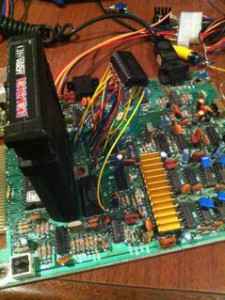So not only did I retrieve a 5 1/4″ floppy drive from my parents recently, but I also grabbed the family Colecovision and my brothers old Acorn Electron. Since this was all fitting in my luggage going from Australia to NZ, the Colecovision was mostly disassembled to bring back. In fact I only bought back the motherboard, metal shield, RF modulator, a coleco joystick and a couple of cartridges. The Colecovision PSU is quite a heavy beast so I left that behind.
So I had tested the Colecovision at my parents house and it was simply dead. Just black screen … nothing. We were pretty sure it had worked perfectly maybe a year or two ago. It didnt help that we couldn’t tune in the analog TV channel for it either on a modern TV. I only had a multimeter at my disposal … and I could see +5, +12 and -5 were getting through where they were supposed to … but nothing was happening.
With the Colecovision board back in NZ, I first had to make up a PSU. I assumed I would wire up an ATX PSU …but my ATX PSU was missing the -5V output (I imagine this has been silently dropped from lots of ATX PSUs). As a crappy hack, a 7905 regulator was wired off the -12V line to get -5V.
Next problem was to get composite output working as I wanted to plug it into my Dell 2001FP. There’s some notes here on the composite mod for PAL Colecovisions. That ended up with some dangling mess of resistors and a transistor.
So plugged it all in, powered on … and still nothing. I had good voltages on all the chips. So now I started hooking my logic analyser in a few places to see what was going on. Rather than go the whole hog of wiring up the databus , first I tried just wiring one or two pins into the analyser. I checked the CPU clock. That was good. I checked the MREQ- line. That was fluctuating. I checked some of the chip enable outputs on the two 74LS138’s and they were doing something. Then I went through the data outs of all the 4116’s and they all had something like a pattern of output in line with something doing some kind of screen DMA.
But still a black screen. A bit of googling for anything about repairing colecovisions and came across this page. So they replaced some 2114’s and maybe some 4116’s. I was reasonably convinced the 4116s weren’t dead, so on a whim decided I would desolder the 2114’s and just replace them with a 6116 (with A10 tied low). Must admit the circuit board does not like being desoldered that much and I didnt do a great job …. and ended up damaging the trace to A7 on the 2114’s. Everything else was fine, so I just ran some wires from the 2114 pads on the board to a 24 pin socket and then plugged a 6116 in.
As you can see it’s quite messy. However, I powered it on and dang it … it worked! I might try and source some old 2114’s as the 6116 hanging out isnt that great. It’s definitely not possible to get the RF shield back on until I figure out how to tidy it up. Must admit in reading more about retro repair stuff, 2114’s and 4116’s seem to have a high failure rate on older systems.
So far I’ve only tried a couple of cartridges; Donkey Kong, Looping, Venture. All are working fine, so the 4116’s must be OK too.
The old Colecovision brings back a lot of memories. The games were very ‘playable’, and the graphics are pretty good all considering. The 9929 VDP (9918) it uses was a cool chip back in the day, and appeared in a few different 80s systems such as TI 99/4A, Dick Smith Wizzard, Sega SC3000, MSX and so on. In fact my brother and I bought 9929’s for our DIY computers as it was easy to interface, had some interesting graphic modes and 32 sprites to play with.
